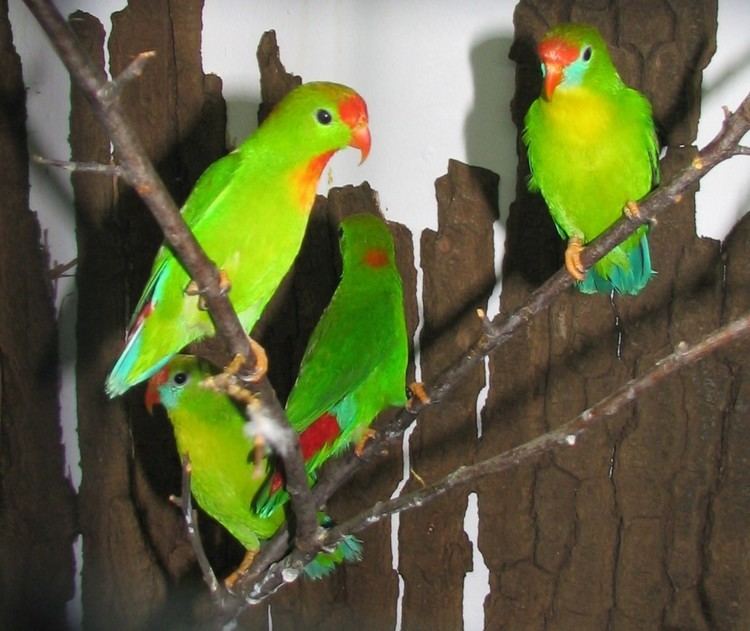Tribe Psittaculini Order Parrot | Superfamily Psittacoidea Subfamily Agapornithinae Genus Loriculus | |
 | ||
Similar Hanging parrot, Parrot, Bird, Blue‑crowned racket‑tail, Moluccan hanging parrot | ||
The Philippine hanging parrot (Loriculus philippensis) is also widely known as the colasisi taken from its local Tagalog name, "kulasisi". It is a small parrot species of the family Psittaculidae. It includes about eleven subspecies, which are all native to only the Philippines; however, the exact taxonomy is unclear, and at least one of the subspecies might become split off and become a separate species if further research provides clarification.
Contents
- Colasisi philippine hanging parrot
- Description
- Taxonomy
- Distribution and habitat
- Behaviour and ecology
- References
They are mainly green with areas of red, orange, yellow, and blue varying between subspecies. Only the males have a red area on their fronts, except for the population living on Camiguin, where neither male nor female have this red area. They make nests in tree holes and, unusually for a parrot, the female takes nesting material back to the nest.
Colasisi philippine hanging parrot
Description
Philippine hanging parrots are about 14 cm (5.5 in) long, weigh 32–40 g, and have a short rounded tail. They are mainly green with areas of red, orange, yellow, and blue varying between subspecies. The forehead is red and the irises are dark brown. Adults have red beaks and orange legs except for Loriculus (philippensis) bonapartei which have black beaks and grey legs. They are sexually dimorphic with only the males having red on their chin or upper chest, except for the Loriculus (philippensis) camiguinensis in which neither the male or female has a red bib or chest. Juveniles have less red on their heads and paler beaks, but otherwise resemble the female.
Taxonomy
The species or species complex was initially described by Statius Müller in 1776. The exact taxonomy listing is unclear.
Loriculus philippensis (Statius Muller) 1776
In 2006, hanging parrots living on the island of Camiguin, off the northern coast of Mindanao, were described and thought to have a separate identity, Loriculus (philippensis) camiguinensis; however, more research and DNA analysis is required to clarify their taxonomy. There is also uncertainty over the taxonomy of Loriculus (philippensis) bonapartei which has been classified as a subspecies or a species in different classifications.
Distribution and habitat
The Philippine hanging parrot is native to the Philippines except the Sulu Archipelago and it is not widespread on Palawan. The different subspecies are native to different islands, and some subspecies are rare or almost extinct. Trading of birds between the islands for pets has resulted in escaped pets living on different islands to where they originated.
Its natural habitats are tropical moist lowland forests, bamboo forest and tropical moist montane forest. It also occupies human-modified habitats including coconut groves and secondary forest. It is most common in lowland areas, being rare above 1250 m.
Behaviour and ecology
Philippine hanging parrots are usually encountered alone or in pairs, rarely in small groups. They mostly forage for food in the canopy or middle storeys of forests, and their diet is composed of nectar and flowers as well as soft fruits such as those from figs (Ficus).
The species is a season breeder, with nesting occurring from March to May. Like most parrots it is a cavity nester; a nest found in the wild was in a cavity high up in a dead tree. However, it is one of the few species of parrots that uses nesting material in the nest, the female tucks nesting material between feathers in order to take it back to the nest. In captivity the clutch size was 3 eggs which are incubated for 20 days. The chicks take around 35 days to fledge after hatching. The rounded eggs measure about 18.7 x 16.4 mm.
